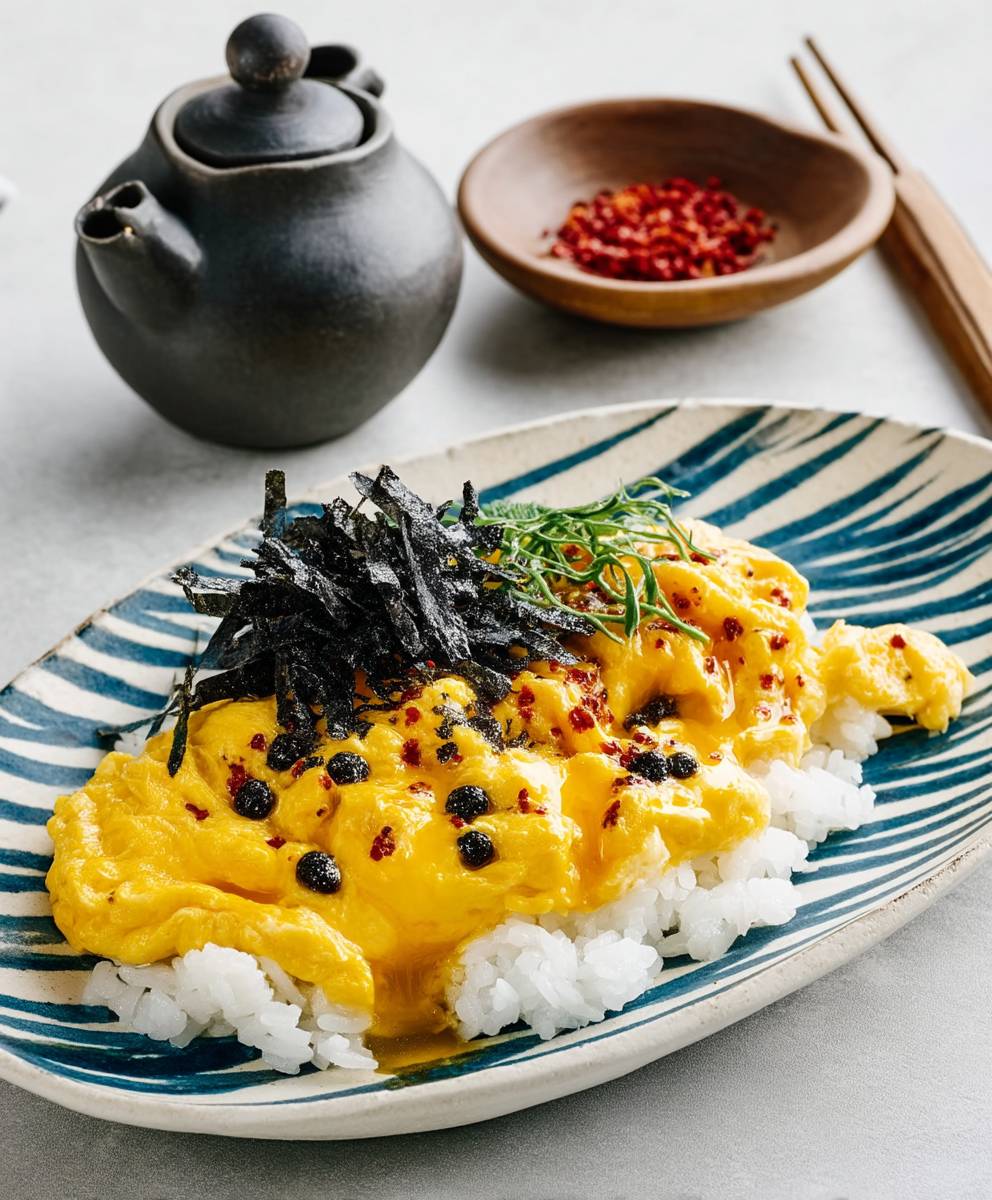Japanese Tamago Rice Bowl, or Tamago Don, is the ultimate comfort food that comes together in minutes! Imagine a steaming bowl of fluffy rice, topped with the silkiest, most flavorful egg you’ve ever tasted. This isn’t just any egg; it’s a delicately sweet and savory custard, cooked to perfection and practically melting in your mouth.
Tamago Don is a staple in Japanese cuisine, often enjoyed as a quick and satisfying lunch or a light dinner. Its simplicity belies its depth of flavor, drawing on the umami-rich dashi broth and the subtle sweetness of soy sauce and mirin. While variations exist, the core of Tamago Don remains the same: a celebration of the humble egg. It’s a dish that speaks to the Japanese appreciation for simple, high-quality ingredients prepared with care.
What makes the Japanese Tamago Rice Bowl so universally loved? It’s the perfect combination of textures and tastes. The creamy, almost pudding-like egg contrasts beautifully with the firm, slightly chewy rice. The savory-sweet sauce is incredibly addictive, making each bite a delightful experience. Plus, it’s incredibly convenient! When you’re short on time but craving something warm and comforting, Tamago Don is the answer. It’s a budget-friendly, easy-to-make meal that will leave you feeling satisfied and happy. So, let’s dive into this classic recipe and learn how to create your own perfect bowl of Tamago Don!
Ingredients:
- For the Tamago (Egg):
- 4 large eggs
- 2 tablespoons dashi (Japanese soup stock), or water
- 1 tablespoon soy sauce
- 1 tablespoon mirin (sweet rice wine)
- 1 teaspoon sugar
- 1/4 teaspoon salt
- 1 tablespoon vegetable oil
- For the Rice:
- 2 cups cooked Japanese short-grain rice, warm
- For the Toppings (Optional):
- 2 green onions, thinly sliced
- Nori seaweed, cut into thin strips
- Sesame seeds (white or black)
- Shichimi Togarashi (Japanese seven spice blend), for a little heat
- Pickled ginger (gari)
Preparing the Tamago (Egg)
Alright, let’s get started with the star of the show the tamago! This is where the magic happens. Don’t be intimidated; it’s easier than it looks, I promise!
- Whisk the Eggs: In a medium bowl, crack all four eggs. Now, whisk them really well until the yolks and whites are fully combined and you have a nice, even yellow color. You don’t want any streaks of white remaining. This is important for a smooth and consistent tamago.
- Add the Flavor: Now, pour in the dashi (or water if you don’t have dashi), soy sauce, mirin, sugar, and salt. Whisk everything together until the sugar and salt are completely dissolved. Give it a little taste it should be a balanced flavor of sweet, savory, and umami. Adjust the sugar or soy sauce to your liking. Remember, you can always add more, but you can’t take it away!
- Strain the Mixture (Optional but Recommended): This step is optional, but I highly recommend it for a super smooth tamago. Pour the egg mixture through a fine-mesh sieve into another bowl. This will remove any bits of egg white that didn’t fully incorporate and will result in a more delicate texture.
Cooking the Tamago
Now comes the fun part cooking the tamago! The key here is low and slow. We want a tender, slightly sweet, and perfectly cooked egg.
- Heat the Pan: Place a non-stick frying pan (preferably a square or rectangular tamagoyaki pan, but a regular round pan will work too) over medium-low heat. Add the vegetable oil and spread it evenly around the pan using a paper towel. You want a very thin layer of oil just enough to prevent sticking. The pan should be hot enough that a drop of the egg mixture sizzles gently, but not so hot that it browns immediately.
- First Layer: Pour a thin layer of the egg mixture into the pan just enough to cover the bottom. It should be a very thin layer, almost like a crepe. Let it cook for a minute or two, until the bottom is set but the top is still slightly wet. You’ll see the edges start to lift slightly.
- Roll It Up: Using chopsticks or a thin spatula, gently lift one edge of the cooked egg and fold it over onto itself, creating a roll. Push the roll to one side of the pan (the side closest to you).
- Second Layer: Add another thin layer of the egg mixture to the empty part of the pan. Lift the cooked egg roll slightly so the new egg mixture can flow underneath it. This will help the layers stick together. Let it cook for a minute or two, until the bottom is set but the top is still slightly wet.
- Roll Again: Roll the cooked egg roll over the new layer of egg, incorporating it into the roll. Push the roll back to the side of the pan.
- Repeat: Repeat steps 4 and 5 until all of the egg mixture is used up. Each time you add a new layer, make sure to lift the existing roll so the new mixture can flow underneath. This will create a beautiful layered effect.
- Final Cook: Once all the egg mixture is used, cook the tamago roll for a minute or two on each side to ensure it’s cooked through. Be careful not to burn it! The goal is a golden-yellow color.
- Shape It (Optional): If you want a perfectly shaped tamago, you can use a bamboo sushi mat (makisu) to shape it while it’s still warm. Wrap the tamago in the mat and gently squeeze to create a more uniform shape. Let it cool in the mat for a few minutes.
Assembling the Tamago Rice Bowl
Now that the tamago is cooked, it’s time to assemble our delicious rice bowl! This is the easiest part.
- Slice the Tamago: Carefully remove the tamago from the pan (or the sushi mat, if you used one). Place it on a cutting board and slice it into 1/2-inch thick slices.
- Prepare the Rice: Make sure your cooked Japanese short-grain rice is warm. If it’s not, you can gently reheat it in the microwave.
- Assemble the Bowl: Place the warm rice in a bowl. Arrange the tamago slices on top of the rice.
- Add Toppings: Now, it’s time to get creative with the toppings! Sprinkle with sliced green onions, nori seaweed strips, and sesame seeds. If you like a little heat, add a pinch of shichimi togarashi. Serve with pickled ginger on the side.
Tips for Perfect Tamago
- Low and Slow: The key to a tender tamago is cooking it over low heat. Don’t rush the process!
- Thin Layers: Adding thin layers of egg mixture will create a beautiful layered effect and ensure that the tamago cooks evenly.
- Don’t Overcook: Overcooked tamago will be dry and rubbery. The goal is a slightly moist and tender texture.
- Adjust the Sweetness: The amount of sugar in the recipe can be adjusted to your liking. If you prefer a less sweet tamago, reduce the amount of sugar.
- Use a Non-Stick Pan: A non-stick pan is essential for preventing the tamago from sticking and tearing.
- Practice Makes Perfect: Don’t be discouraged if your first tamago isn’t perfect. It takes a little practice to get the technique down. Keep trying, and you’ll be making perfect tamago in no time!
Variations
- Add Vegetables: You can add finely chopped vegetables to the egg mixture, such as spinach, carrots, or mushrooms.
- Add Cheese: For a richer flavor, add a little grated cheese to the egg mixture.
- Add Meat: You can add cooked and crumbled meat to the egg mixture, such as ham, bacon, or sausage.
- Make it Spicy: Add a pinch of chili flakes or a dash of hot sauce to the egg mixture for a spicy kick.
- Use Different Toppings: Get creative with the toppings! Try adding avocado, kimchi, or a fried egg.
Serving Suggestions
This Tamago Rice Bowl is delicious on its own, but it also pairs well with other Japanese dishes, such as miso soup, edamame, or a side salad. It’s perfect for a quick and easy lunch or dinner.
Enjoy your homemade Tamago Rice Bowl! I hope you love it as much as I do.

Conclusion:
This Japanese Tamago Rice Bowl isn’t just a meal; it’s a warm hug in a bowl, a quick trip to Japan without the jet lag, and a guaranteed crowd-pleaser, even if that crowd is just you! I truly believe this recipe is a must-try for anyone looking for a comforting, flavorful, and incredibly easy dish to add to their repertoire. The delicate sweetness of the dashi-infused egg, combined with the savory soy sauce and the fluffy rice, creates a symphony of flavors that will have you craving it again and again. It’s the perfect weeknight dinner solution, a delightful lunch option, or even a satisfying late-night snack.
But the best part? It’s incredibly versatile! Feel free to experiment with different toppings to customize your bowl to your liking. For a spicier kick, add a dash of sriracha or a sprinkle of chili flakes. If you’re a fan of green onions, don’t hesitate to load them on! A sprinkle of toasted sesame seeds adds a nutty crunch, while a drizzle of sesame oil enhances the overall aroma and flavor. For a heartier meal, consider adding some grilled chicken or thinly sliced beef. You could even incorporate some sautéed mushrooms or spinach for added nutrients and texture.
And speaking of variations, if you’re feeling adventurous, try using different types of rice. While short-grain Japanese rice is the traditional choice, brown rice or even quinoa can be delicious alternatives. You can also experiment with different types of soy sauce. A light soy sauce will provide a more delicate flavor, while a dark soy sauce will add a richer, more intense taste.
This Tamago Rice Bowl is truly a blank canvas for your culinary creativity. Don’t be afraid to experiment and find your perfect combination of flavors and toppings. I’ve made it countless times, and each time I tweak it slightly to suit my mood and what I have on hand.
I’m confident that you’ll love this recipe as much as I do. It’s simple, satisfying, and endlessly adaptable. It’s the kind of dish that you can whip up in minutes, yet it tastes like you spent hours slaving away in the kitchen. Plus, it’s a great way to use up leftover rice!
So, what are you waiting for? Grab your ingredients, put on some relaxing music, and get ready to create your own delicious Tamago Rice Bowl masterpiece. I promise you won’t be disappointed.
And most importantly, I want to hear about your experience! Did you try the recipe? What variations did you make? What did you think of the flavor? Share your photos and stories in the comments below. I’m always eager to see how others are enjoying my recipes and to learn new tips and tricks. Let’s build a community of Tamago Rice Bowl enthusiasts! Happy cooking! I can’t wait to hear from you! Let me know if you have any questions, and I’ll do my best to answer them. Enjoy!
Japanese Tamago Rice Bowl: A Delicious & Easy Recipe
Sweet and savory Japanese rolled omelet (tamago) served over warm rice with flavorful toppings. A simple and satisfying Tamago Rice Bowl.
Ingredients
- 4 large eggs
- 2 tablespoons dashi (Japanese soup stock), or water
- 1 tablespoon soy sauce
- 1 tablespoon mirin (sweet rice wine)
- 1 teaspoon sugar
- 1/4 teaspoon salt
- 1 tablespoon vegetable oil
- 2 cups cooked Japanese short-grain rice, warm
- 2 green onions, thinly sliced
- Nori seaweed, cut into thin strips
- Sesame seeds (white or black)
- Shichimi Togarashi (Japanese seven spice blend), for a little heat
- Pickled ginger (gari)
Instructions
- Whisk the Eggs: In a medium bowl, crack all four eggs. Whisk them really well until the yolks and whites are fully combined and you have a nice, even yellow color.
- Add the Flavor: Pour in the dashi (or water if you don’t have dashi), soy sauce, mirin, sugar, and salt. Whisk everything together until the sugar and salt are completely dissolved. Taste and adjust the sugar or soy sauce to your liking.
- Strain the Mixture (Optional but Recommended): Pour the egg mixture through a fine-mesh sieve into another bowl for a super smooth tamago.
- Heat the Pan: Place a non-stick frying pan (preferably a square or rectangular tamagoyaki pan, but a regular round pan will work too) over medium-low heat. Add the vegetable oil and spread it evenly around the pan using a paper towel.
- First Layer: Pour a thin layer of the egg mixture into the pan just enough to cover the bottom. Let it cook for a minute or two, until the bottom is set but the top is still slightly wet.
- Roll It Up: Using chopsticks or a thin spatula, gently lift one edge of the cooked egg and fold it over onto itself, creating a roll. Push the roll to one side of the pan (the side closest to you).
- Second Layer: Add another thin layer of the egg mixture to the empty part of the pan. Lift the cooked egg roll slightly so the new egg mixture can flow underneath it. Let it cook for a minute or two, until the bottom is set but the top is still slightly wet.
- Roll Again: Roll the cooked egg roll over the new layer of egg, incorporating it into the roll. Push the roll back to the side of the pan.
- Repeat: Repeat steps 4 and 5 until all of the egg mixture is used up. Each time you add a new layer, make sure to lift the existing roll so the new mixture can flow underneath.
- Final Cook: Once all the egg mixture is used, cook the tamago roll for a minute or two on each side to ensure it’s cooked through. Be careful not to burn it!
- Shape It (Optional): If you want a perfectly shaped tamago, you can use a bamboo sushi mat (makisu) to shape it while it’s still warm. Wrap the tamago in the mat and gently squeeze to create a more uniform shape. Let it cool in the mat for a few minutes.
- Slice the Tamago: Carefully remove the tamago from the pan (or the sushi mat, if you used one). Place it on a cutting board and slice it into 1/2-inch thick slices.
- Prepare the Rice: Make sure your cooked Japanese short-grain rice is warm. If it’s not, you can gently reheat it in the microwave.
- Assemble the Bowl: Place the warm rice in a bowl. Arrange the tamago slices on top of the rice.
- Add Toppings: Sprinkle with sliced green onions, nori seaweed strips, and sesame seeds. If you like a little heat, add a pinch of shichimi togarashi. Serve with pickled ginger on the side.
Notes
- The key to a tender tamago is cooking it over low heat. Don’t rush the process!
- Adding thin layers of egg mixture will create a beautiful layered effect and ensure that the tamago cooks evenly.
- Overcooked tamago will be dry and rubbery. The goal is a slightly moist and tender texture.
- The amount of sugar in the recipe can be adjusted to your liking. If you prefer a less sweet tamago, reduce the amount of sugar.
- A non-stick pan is essential for preventing the tamago from sticking and tearing.
- Don’t be discouraged if your first tamago isn’t perfect. It takes a little practice to get the technique down. Keep trying, and you’ll be making perfect tamago in no time!





Leave a Comment